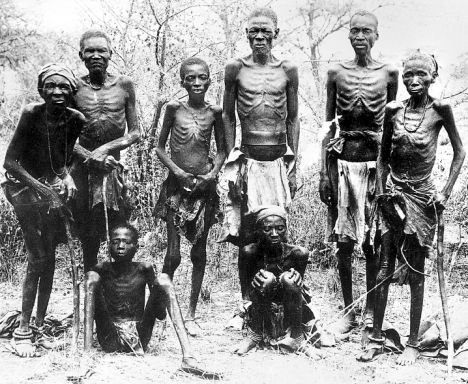Germans have always claimed that Nazism was an aberration in their history and thinking. Now they may want to rediscover their past and reassess the Second Reich. Perhaps claiming this as an aberration is an excuse to avoid looking within.
Germany's first genocide did not begin with the Third Reich; it started much earlier. This travesty began at the dawn of the 20th century in concentration camps run by the Kaisers Second Reich's armies. This horrific implantation was 30 years before Hitler even came to power.
In the 1870s, with Germany facing overcrowding, the theory of Lebensraum became central for practical purposes and racially motivated aspects. Many Germans were living in poverty, and others were moving to the United States. The option seemed viable for Lebensraum in what was then called German Southwest Africa.
In Africa, they could spread German culture and settle German farming families. Yet by 1903, only 4,000 settlers preferred Africa to New York. One of the main problems was that Africans were already occupying that land. Yet, for the German thinking, that did not phase them. If they wanted that land, they would have to take it.
Those with the best land were the Hereros; this civilization was extremely well established and could read and write, and they had firearms. This group also was not out of touch with the rest of the world, and they were well connected. It was a paradoxical situation because Germans arriving with a supremacist theory now had to rent and buy cattle from the locals, which they resented.
German soldiers, who believed later they would be settlers, were so confident of their superiority that they began treating the Africans with impunity. Hereros could be abused in any way but had no way to redress the issue. They could be beaten, raped, or murdered without recourse in a court of law.
The Hereros, seeing no other way out, knowing that the Germans intended to take their land and enslave them believed they had to rebel. Finally, German extremists pushed their criminal behavior too far, and at that point, Hereros took their revenge against the Germans. Over 100 German soldiers and settlers were murdered over the first few days.
At this point, the ethnic cleansing began. Yet, there was a problem; this was not a centralized event. Only a portion of the Hereros rebelled. The Germans needed to manipulate this into a race war. Many Hereros had even claimed loyalty to the Germans who once were missionaries to them, but the soldiers continued to perpetuate myths about Herero crimes. This was an unfair, dubious, and cruel event.
The governor began negotiations with the Herero leader. Still, when news got back to Germany, imperialists wanted to use the uprising as a pretext to take over the country entirely. The governor was attacked for his soft policies by the German government.
Herero were not a people to negotiate with for the press but savages that must be crushed. Rapists and child murderers. They manipulated the public, constructing an enemy that did not exist; this would later happen with the Polish when the Germans started World War II. It was all a plan created to manipulate the public, creating an enemy that wasn't there.
The next move was to send an army with the fearsome General Von Trotha. But it was problematic because, essentially, the uprising was over. After twice fighting the German garrisons to a stalemate, they ceased contact. They moved as far away as possible to Waterberg, waiting for negotiations.
Instead of planning negotiations, more and more German soldiers arrived with vast supplies of the latest artillery and ammunition. Convinced of his superiority, the army moved to Waterberg. On the 11th of August 1904, the battle to eradicate the Herero began.
The Germans left one side open so it would be weaker, and the only escape would be into the desert, which is what happened. Once they fled into the desert, the Germans sealed the area off, and the Herero began to die from thirst and starvation.
Then Von Trotha put down in writing his plans for genocide. When news of the atrocities reached Berlin, there were some protests from the Center Party, and it became a scandal, but despite this, the Kaiser allowed this to proceed. The government finally forced the hand of the Kaiser and Von Trotha to accept the Herero people's surrender.
Thirteen thousand were rounded up and told they were pardoned, but that was a lie. This was the beginning of Germany's concentration camps, where the Herero were beaten and starved to death. Germans then used some of the Herero laborers for their industry, women, and children. The conditions themselves proved fatal because of the weather conditions and scarce food.
Germans soon began renting Herero's to private companies. These companies also had camps where they used the Herero as laborers. Germans were meticulous about records, and as for the cause of death, it was usually listed as exhaustion – often, these records were pre-printed. All through Namibia, the prisoners were worked to death.
One particular place was not about slave labor but about extermination. Shark Island was about murder, and everyone knew. This would become the camp for eradicating the Nama people because, apparently, to the Germans, they had no merit. Possibly this was just like those the Germans would eliminate later. They deemed them not worth living in their land because they did not live up to the Aryan standard. This place of horror is now a camping site, and the tourists have no clue they are camping on the blueprint for the first death camp.
Soldiers also began selling heads to scientists, using these to prove racial superiority theories. Half of Herero were dead, and three-fourths of the Nama were exterminated. All of this was forgotten and swept aside, but the racial theories lived on and would be recalled and used in the Second World War.
Many of the soldiers involved in the German genocide in Namibia would later be involved in the Freikorps. They would propagate the same ideology of Lebensraum, all connected to the Second Reich.
The same racial theories used on the Herero and Nama would be used by the Germans when they saw victims as sub-humans.
The crimes and theories from the Second Reich are intricately connected, and historians hardly recognize this. There are no memorials to the Africans, yet there are memorials to the Germans. This long-erased past is now being remembered.



Dodaj
komentarz
By dodać komentarz musisz być zalogowany. Zaloguj się.
Nie masz jeszcze konta? Zarejestruj się.